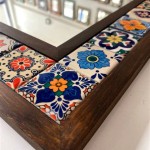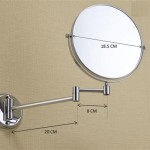Two-Way Mirror Glass Vs. Acrylic: A Comparative Analysis
Two-way mirrors, also known as one-way mirrors or observation mirrors, are widely used in various applications, including security, surveillance, theatrical effects, and psychological research. These mirrors create the illusion of a standard mirror on one side while allowing viewing from the opposite side under controlled lighting conditions. The functionality of a two-way mirror hinges on the principle of unequal illumination, with the viewing side being significantly darker than the mirrored side. While traditional two-way mirrors are manufactured using glass as the base material, acrylic alternatives have emerged, offering distinct advantages and disadvantages. This article provides a detailed comparative analysis of two-way mirror glass and acrylic, examining their respective properties, performance characteristics, and suitability for different applications.
The fundamental difference between two-way mirror glass and acrylic lies in the base material's composition and manufacturing process. Two-way mirror glass is created by applying a thin, semi-transparent coating of metal, typically aluminum or silver, to one side of a glass pane. This coating reflects a portion of the light striking it while also allowing a portion to pass through. The mirrored effect is most pronounced when the lighting on the observed side is significantly brighter than the lighting on the viewing side. Two-way mirror acrylic, on the other hand, utilizes a similar metallic coating applied to an acrylic sheet. Acrylic, also known as polymethyl methacrylate (PMMA), is a synthetic polymer known for its transparency, lightweight properties, and shatter resistance.
The choice between two-way mirror glass and acrylic depends on a variety of factors, including the specific application requirements, budget considerations, and aesthetic preferences. Each material possesses unique strengths and weaknesses that must be carefully evaluated to determine the optimal solution.
Optical Clarity and Distortion
Optical clarity is a critical consideration for any mirror application, particularly when observation is involved. Glass, by its nature, offers superior optical clarity compared to acrylic. The inherent structure of glass allows for minimal distortion, resulting in a clearer and more accurate reflection. This is particularly important in applications where precise visual information is required, such as security surveillance or psychological research. Any distortion introduced by the mirror can compromise the integrity of the observed data or hinder the effectiveness of security monitoring.
Acrylic, while transparent, is more susceptible to distortion than glass. The manufacturing process of acrylic sheets can introduce slight surface irregularities that can lead to reflections that are slightly warped. This distortion may not be noticeable in all applications, but it can be a significant drawback in situations where image accuracy is paramount. Furthermore, acrylic is prone to scratching, which can further degrade its optical clarity over time. The accumulation of scratches on the mirrored surface can scatter light, reducing the reflectivity and clarity of the reflection.
In summary, for applications demanding the highest level of optical clarity and minimal distortion, two-way mirror glass is generally the preferred choice. However, if slight distortion is acceptable and other factors, such as weight or shatter resistance, are more important, acrylic may be a viable alternative.
Durability and Shatter Resistance
Durability and shatter resistance are crucial considerations for two-way mirrors, especially in high-traffic areas or environments where there is a risk of impact. Glass, while possessing excellent optical clarity, is relatively brittle and prone to shattering upon impact. When shattered, glass can break into sharp fragments, posing a significant safety hazard. This makes two-way mirror glass unsuitable for applications where safety is a primary concern.
Acrylic, on the other hand, is significantly more shatter-resistant than glass. It is less likely to break or shatter upon impact, and if it does break, it tends to break into larger, less hazardous pieces. This makes two-way mirror acrylic a safer option for applications where there is a risk of accidental breakage, such as in schools, hospitals, or public spaces. The impact resistance of acrylic also makes it a more suitable material for portable or temporary installations, where the mirror may be subjected to handling and transport.
However, while acrylic is more shatter-resistant than glass, it is also more susceptible to scratching. The soft surface of acrylic is easily scratched by abrasive materials or cleaning agents. These scratches can diminish the optical clarity of the mirror over time, requiring periodic replacement. Therefore, it is important to handle and clean acrylic mirrors with care, using appropriate cleaning solutions and soft cloths.
In applications where safety is paramount and the risk of impact is high, two-way mirror acrylic offers a significant advantage over glass. However, the susceptibility of acrylic to scratching must be considered, and appropriate maintenance procedures should be implemented to preserve its optical clarity.
Weight and Installation
Weight and ease of installation are practical considerations that can influence the choice between two-way mirror glass and acrylic. Glass is significantly heavier than acrylic, which can make it more challenging to handle and install, particularly in large sizes. The weight of glass can also necessitate stronger support structures, adding to the overall cost of the installation.
Acrylic, being much lighter than glass, is easier to handle and install. Its lower weight reduces the strain on support structures and simplifies the installation process. This can be particularly advantageous in applications where the mirror needs to be moved or reconfigured frequently, such as in temporary exhibits or mobile security units. The lightweight nature of acrylic also makes it a suitable material for applications where weight is a limiting factor, such as in aircraft or vehicles.
The ease of installation associated with acrylic can also translate into cost savings. The reduced labor required for handling and installing acrylic mirrors can lower the overall project cost. Furthermore, acrylic can be cut and shaped more easily than glass, allowing for greater design flexibility and customization. This can be particularly beneficial in applications where the mirror needs to conform to specific architectural features or design constraints.
In summary, for applications where weight is a concern or ease of installation is desired, two-way mirror acrylic is typically the preferred choice. The reduced weight of acrylic simplifies handling, installation, and transportation, potentially leading to cost savings and greater design flexibility.
Beyond the core aspects of optical clarity, durability, and weight, other factors contribute to the decision-making process. Cost is invariably a consideration, with acrylic often presenting a more economical solution, particularly for larger installations, due to the reduced material and labor costs. However, the long-term cost-effectiveness should be evaluated by factoring in potential replacement costs associated with acrylic's susceptibility to scratching.
Another important aspect is the size limitation. While both glass and acrylic can be manufactured in a variety of sizes, glass generally offers more options for larger, seamless installations. Large acrylic sheets are more prone to warping and distortion, which can limit their practical application in oversized mirror configurations. Therefore, for projects requiring very large two-way mirrors, glass may be the only viable option despite its higher weight and installation costs.
Environmental considerations also play a role. Acrylic is a petroleum-based product, and its manufacturing process can have a significant environmental impact. Glass, on the other hand, can be recycled, making it a more sustainable option in some cases. The availability of recycled acrylic is limited, further reinforcing the environmental advantage of glass in situations where sustainability is a priority.
Finally, the specific application environment should be taken into account. In environments with high humidity or exposure to corrosive chemicals, the reflective coating on both glass and acrylic can degrade over time. However, glass is generally more resistant to chemical degradation than acrylic. Therefore, in harsh environments, glass may be the more durable and long-lasting option.
In conclusion, the selection between two-way mirror glass and acrylic is a multifaceted decision that necessitates a careful evaluation of various factors, including optical clarity, durability, weight, cost, size limitations, environmental impact, and application environment. By thoroughly assessing these factors, specifiers can make an informed choice that optimizes performance, safety, and cost-effectiveness for their specific needs.

Fingernail Test Comparison Between Standard Mirror And Acrylic Two Way Mirrors

Choosing Glass Or Acrylic For Your Smart Mirror Built By Az

News Which Kind Of Plastic Mirrors Can Replace Glass Without Deformation In The Case Large Areas

Two Way Mirrors Glass Acrylic Magic Mirror Central

Choosing Between Acrylic Mirror Sheets Vs Glass Mirrors

How To Detect A Two Way Mirror Fingernail Test

Two Way Mirrors Glass Acrylic Magic Mirror Central

Allplastics Engineering Pc Hardcoat Mirror

Smart Mirror Glass 3 Reasons To Buy This Magic Central

Allplastics Engineering Pc Hardcoat Mirror








